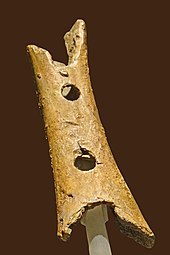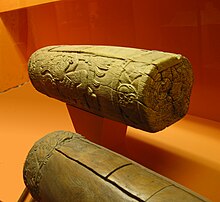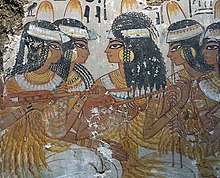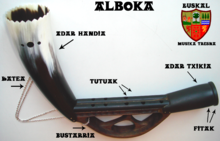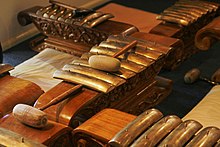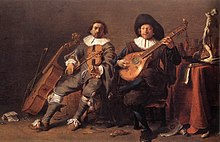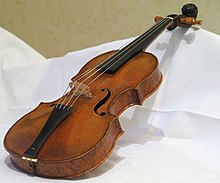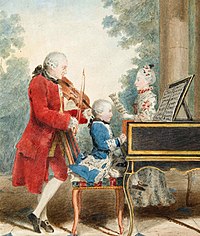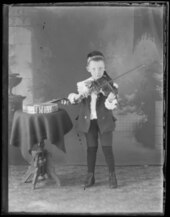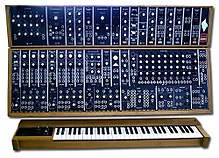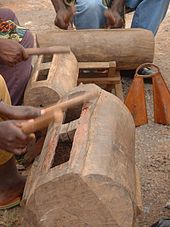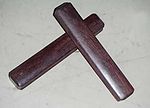Musical instrument
A musical instrument is an object composed of the combination of one or more resonant systems and means for their vibration, built in order to produce sound in one or more tones that can be combined by a performer to produce music. In the end, anything that produces harmonic sound can serve as a musical instrument, but the expression is generally reserved for objects that have that specific purpose.
The human body, has been generating sounds through the vocal and percussive upper airways, it was probably the first instrument. Sachs and others have speculated about the ability of Homo habilis to add sounds idiophonically to impulses of motor emotional expression such as dance, using various media such as stones, hollow logs, bracelets, shells, and ox teeth. animals.
Archaeological excavations and others have found sixty thousand-year-old bone-edged aerophones (flutes). It is evident that some aerophones produce sound by the natural action of the wind (on bamboo canes), offering the sound phenomenon to the casual observer. Likewise, other aerophones such as animal horns, due to the volume of the sounds produced, could be and were used as sound signal instruments for hunting. The large number of wind, string and percussion musical instruments found in archaeological excavations of all the great ancient civilizations and the extensive pictorial and literary documentation coincide with the great importance that music has always had for human beings.
In the days of Ptolemaic Egypt, the engineer Ctesibius of Alexandria developed the hydraulic organ or hydraulis, designed to produce melodies with a great volume of sound, which could be used in circus performances on the air.
The oldest instrument is the flute, it was invented by Homo habilis in the Paleolithic and was made of bird bone and mammoth ivory, this instrument is around 42,000
Archaeology
Researchers have discovered archaeological evidence of musical instruments in many parts of the world. Some artifacts have been dated as 67,000 years old, while critics often dispute the finds. Consensus on artifacts dating to around 37,000 years old and later is consolidating. Artifacts made of durable materials, or constructed with durable methods, have been found to have survived. Therefore, the specimens found cannot be irrefutably located as early musical instruments.
In July 1995, Slovenian archaeologist Ivan Turk discovered a bone carving in northwestern Slovenia. The carving, called Divje Babe's Flute, features four holes that Canadian musicologist Bob Fink determined could have been used to play four notes of a diatonic scale. Researchers estimate the flute to be between 43,400 and 67,000 years old, making it the oldest known musical instrument and the only musical instrument associated with Neanderthal culture. However, some archaeologists and ethnomusicologists dispute the status of the flute. flute as a musical instrument. German archaeologists have found mammoth bone and swan bone flutes dating from 30,000 to 37,000 years old in the Swabian Alps. Flutes were made in the Upper Paleolithic, and are more commonly accepted as the oldest known musical instruments.
Archaeological evidence of musical instruments was discovered in excavations of the Royal Burial Ground in the Sumerian city of Ur. These instruments, one of the first sets of instruments discovered to date, include nine lyres (Lyres of Ur), two harps, a silver double flute, a sistrum and cymbals. A set of reed-sounding silver pipes discovered at Ur was the probable predecessor of modern bagpipes. The cylindrical pipes feature three side holes that allowed players to produce a whole-tone scale. These excavations, carried out by Leonard Woolley in the 1920s, unearthed fragments of undegraded instruments and the voids left by the degraded segments which, taken together, have served to reconstruct them. The graves in which these instruments were buried have been dated using the carbon technique between 2600 and 2500 BC. C., providing evidence that these instruments were in use in Sumer at this time.
Archaeologists at the Jiahu site in central China's Henan province have found bone-made flutes dating to between 7,000 and 9,000 years ago, representing some of the earliest "complete, playable musical instruments, date adjusted and multinotic" never found.
History
Scholars agree that there are no completely reliable methods for determining the exact chronology of musical instruments in different cultures. Comparing and organizing instruments based on their complexity is misleading, as advances in musical instruments have sometimes reduced complexity. For example, the construction of the first slit drums involved the felling and hollowing out of large trees; later slit drums were made by splitting bamboo stalks, a much simpler task.
German musicologist Curt Sachs, one of the foremost musicologists and musical ethnologists of modern times, argues that it is misleading to order the development of musical instruments by their making, since cultures advance at different rates and have access to different raw materials. For example, contemporary anthropologists comparing musical instruments from two cultures that existed at the same time but differ in organization, culture, and craftsmanship are unable to determine which instruments are more 'primitive'. Sorting instruments by geography it is also not reliable, since it is not always possible to determine when and how cultures came into contact and shared knowledge. However, Sachs proposed that a geographic chronology up to about 1400 is preferable, due to its limited subjectivity. Beyond 1400, the general development of musical instruments can be followed over time.
The science of marking the order of development of musical instruments is based on archaeological artifacts, artistic representations, and literary references. Since the data from one research track may not be conclusive, all three tracks provide a better historical picture.
Prehistory
Until the 19th century AD. C., musical histories written in Europe began with mythological accounts mixed with scriptures about how musical instruments were invented. Such accounts included Jubal, descendant of Cain and "father of all who play the harp and organ" (Genesis 4:21) Pan, inventor of the pipe, and Mercury, who is said to have turned a dry tortoise shell into the first lyre. Modern histories have replaced this mythology with anthropological speculation, sometimes based on archaeological evidence. Scholars agree that there was no "invention" definitive of the musical instrument, since the term "musical instrument" it is subjective and difficult to define.
Among the earliest devices external to the human body to be considered instruments were maracas, stampers, and various drums. These instruments evolved due to the human motor drive to add sound to emotional movements such as dance. Over time, some cultures they assigned ritual functions to their musical instruments, using them for hunting and various ceremonies. These cultures developed more complex percussion instruments and other instruments such as ribbon reeds, flutes, and trumpets. Some of these labels have very different connotations than those used today; primitive flutes and trumpets are so labeled for their basic operation and function rather than their resemblance to modern instruments. Among the earliest cultures for whom drums developed ritual, even sacred, importance were the Chukchi people of the Far East Russian, the indigenous peoples of Melanesia and many cultures of Africa. In fact, drums were ubiquitous in all African cultures. An East African tribe, the Wahinda, believed that it was so sacred that the sight of a drum would be fatal to anyone but the sultan.
Over time, humans developed the concept of using musical instruments to produce melody, previously common only in singing. Like the process of reduplication in the language, the instrumentalists first developed the repetition and then the arrangement. One of the earliest forms of melody was produced by striking two stamping tubes of slightly different sizes: one tube produced a "clear" and the other would respond with a "darker" sound. Among the pairs of instruments of this type were also churingas, slit drums, shells and skin drums. The cultures that used these pairs of instruments associated them with gender; the "father" was the largest or most energetic instrument, while the "mother" it was the smallest or dullest instrument. Musical instruments existed in this form for thousands of years before patterns of three or more tones evolved into the form of the first xylophone. Xylophones originated on the mainland and in the Southeast Asian archipelago, eventually spreading to Africa, America and Europe. Along with xylophones, which ranged from simple sets of three "leg bars" to carefully tuned sets of parallel bars, various cultures developed instruments such as the earthen harp, earthen zither, musical bow, and mouth harp. Recent research on wear and tear and acoustics of stone artifacts has revealed a possible new class of prehistoric musical instrument, known as lithophones.
Antiquity
Images of musical instruments begin to appear on Mesopotamian artifacts in 2800 BCE. C. or before. From the year 2000 a. C., the cultures of Sumer and Babylonia began to delineate two different classes of musical instruments due to the division of labor and the evolution of the class system. Folk instruments, simple and playable by anyone, evolved differently from professional instruments whose development focused on efficiency and skill. Despite this development, very few musical instruments have been recovered from Mesopotamia. Scholars must rely on artifacts and cuneiform texts written in Sumerian or Akkadian to reconstruct the early history of musical instruments in Mesopotamia. Even the process of naming these instruments is challenging, as there is no clear distinction between the various instruments and the words used to describe them.
Although Sumerian and Babylonian artists depicted primarily ceremonial instruments, historians have distinguished six idiophones used in early Mesopotamia: shock sticks, clappers, sistra, bells, cymbals, and rattles. Sistra are prominently depicted on a large relief of Amenhotep III, and are of special interest because similar designs have been found in far away places such as Tbilisi, Georgia, and among the Native Americans of the Yaqui tribe. Mesopotamian peoples favored stringed instruments, as evidenced by their proliferation in figurines, plaques and Mesopotamian seals. Countless varieties of harps are represented, as well as lyres and lutes, forerunners of modern stringed instruments such as the violin.
Musical instruments used by Egyptian culture before 2700 B.C. C. presented a striking similarity to those of Mesopotamia, which led historians to conclude that the civilizations must be in contact with each other. Sachs points out that Egypt did not possess any instruments that the Sumerian culture did not possess as well. However, around 2700 BC. C. cultural contacts seem to have dissipated; the lyre, a prominent ceremonial instrument in Sumer, did not appear in Egypt for another 800 years. Clappers and shock sticks appear on Egyptian vases as early as 3000 BC. The civilization also made use of sistra, upright flutes, double clarinets, bowed and angular harps, and various drums.
Little history is available on the period between 2700 B.C. C. and 1500 a. C., since Egypt (and indeed, Babylon) entered a long and violent period of war and destruction. This period saw the Kassites destroy the Babylonians in Mesopotamia and the Hyksos destroy the Middle Kingdom of Egypt. When the pharaohs of Egypt conquered Southwest Asia around 1500 B.C. In BC, cultural ties to Mesopotamia were renewed, and the musical instruments of Egypt also reflected a strong influence from Asian cultures. Under their new cultural influences, the people of the New Kingdom began to use oboes, trumpets, lyres, lutes, castanets and cymbals.
Unlike in Mesopotamia and Egypt, professional musicians did not exist in Israel between 2000 and 1000 BCE. C. While the history of musical instruments in Mesopotamia and Egypt is based on artistic representations, the culture in Israel produced few such representations. Therefore, scholars should rely on information obtained from the Bible and the Talmud. The Hebrew texts mention two prominent instruments associated with Jubal: the ugab (pipes) and the kinnor. (lyre). Other instruments of the time were the tof (frame drum), the pa'amon (small bells or rattles), the shofar and the hasosra, similar to a trumpet.
The establishment of a monarchy in Israel during the s. XI a. C. produced the first professional musicians and with them a drastic increase in the number and variety of musical instruments. However, the identification and classification of instruments remains a challenge due to the lack of artistic interpretations. For example, stringed instruments of uncertain design called nevals and asors existed, but neither archeology nor etymology can clearly define them. In her book A Survey of Musical Instruments, American musicologist Sibyl Marcuse proposes that the nevel should be similar to the upright harp due to its relationship to nabla, the Phoenician term for "harp".
In Greece, Rome, and Etruria, the use and development of musical instruments contrasted with the achievements of those cultures in architecture and sculpture. Instruments of the time were simple and virtually all were imported from other cultures. Lyres were the main instrument, as musicians used them to honor the gods. The Greeks played a variety of wind instruments that they classified as aulós (reeds) or syrinx (flutes); Greek writings from that time reflect a serious study of reed production and playing technique. The Romans played reed instruments called tibia, with side holes that could be opened or closed, thus it allowed greater flexibility in playing modes. Other instruments in common use in the region included upright harps derived from those of the East, lutes of Egyptian design, various pipes and organs, and clappers, which were played mainly by women..
Evidence that the early civilizations of India used musical instruments is almost non-existent, so it is impossible to reliably attribute the instruments to the Mundan and Dravidian-speaking cultures, which were the first to settle on Earth. zone. The history of musical instruments in the area begins rather with the Indus Valley civilization that arose around 3000 BC. Various rattles and whistles found among the excavated artifacts are the only physical evidence of musical instruments. A clay figurine indicates the use of drums, and examination of Indus script has also revealed depictions of upright bowed harps identical in design. to those represented in Sumerian artifacts. This discovery is one of many indications that the Sumerian and Indus Valley cultures maintained cultural contact. The further evolution of musical instruments in India came with the Rigveda, or hymns. Various drums, shell trumpets, harps, and flutes were used in these songs. Other notable instruments in use during the early centuries AD included the snake deceiver double clarinet, bagpipes, barrel drums, cross flutes, and short lutes. Altogether, India did not have unique musical instruments until the post-classical era.
Musical instruments such as zithers appeared in Chinese writings around the s. XII a. and before. Early Chinese philosophers, such as Confucius (551-479 BC), Mencius (372-289 BC), and Laozi, influenced the development of musical instruments in China, taking an attitude towards music similar to that of the Greeks. The Chinese believed that music was an essential part of character and community, and developed a unique system of classifying their musical instruments based on their material composition.
Idiophones were extremely important in Chinese music, which is why most early instruments were idiophones. Shang dynasty poetry mentions bells, chimes, drums, and globular flutes carved from bone, the latter excavated and preserved by archaeologists. The Zhou dynasty saw percussion instruments such as clappers, troughs, wooden fish, and yǔ (wooden tiger). Wind instruments such as the flute, panpipes, recorders, and mouth organs also appeared in this period. The xiao (an end-blown flute) and various other instruments that were spread across many cultures, they came into use in China during and after the Han dynasty.
Although the civilizations of Central America reached a relatively high level of sophistication in the 11th century AD. C., they lagged behind other civilizations in the development of musical instruments. For example, they did not have string instruments; all their instruments were idiophones, drums, and wind instruments such as flutes and trumpets. Of these, only the flute was capable of producing a melody. In contrast, the pre-Columbian civilizations of South America in areas such as present-day Peru, Colombia, Ecuador, Bolivia, and Chile were less culturally advanced but more musically advanced. South American cultures of the time used panpipes, as well as varieties of flutes, idiophones, drums, and shell or wooden trumpets.
One instrument that can be attested to the Iron Age Celts is the carnyx which is dated to ~300 BC. C., the elongated trumpet-shaped instrument that had the bell end made of bronze in the shape of a screaming animal head that was held high above their heads, when blown into it, the carnyx made a sound deep and rough, the head also had a tongue that clicked when vibrated, the instrument was intended to be used on the battlefield to intimidate opponents.
Postclassic/Middle Ages
During the time period loosely referred to as the Post-Classical era and Europe in particular as the Middle Ages, China developed a tradition of integrating musical influence from other regions. The first record of this type of influence dates from the year 384 AD. C., when China established an orchestra at its imperial court after a conquest in Turkestan. Influences from the Middle East, Persia, India, Mongolia and other countries followed. Indeed, Chinese tradition attributes many musical instruments from this period to those regions and countries. Cymbals gained popularity, along with more advanced trumpets, clarinets, pianos, oboes, flutes, drums, and lutes. Some of the earliest zithers from bow appeared in China in the IX or X, influenced by Mongolian culture.
India experienced a development similar to that of China in the post-classical era; however, stringed instruments developed differently as they adapted to different musical styles. While the stringed instruments of China were designed to produce precise tones capable of matching the tones of bells, the stringed instruments of India were considerably more flexible. This flexibility suited the slides and tremolos of Indian music. Rhythm was of paramount importance in Indian music of the time, as evidenced by the frequent depiction of drums on reliefs dating from the post-classical period. The emphasis on rhythm is a native aspect of Indian music. Historians divide the development of musical instruments in medieval India between the pre-Islamic and Islamic periods due to the different influence each period provided.
In pre-Islamic times, idiophones such as hand bells, cymbals, and peculiar gong-like instruments were widely used in Hindu music. The gong-like instrument was a bronze disc struck with a hammer rather than a mallet. The tubular drums, wooden zithers (veena), short viols, double and triple flutes, coiled trumpets, and curved horns from India emerged in this time period. Islamic influences brought new types of drum, perfectly circular or octagonal as opposed to irregular pre-Islamic drums. Persian influence brought oboes and sitars, although Persian sitars had three strings and the Indian version had four to seven strings. Islamic culture also introduced double clarinet instruments such as the Alboka (from Arabic, al-buq or "horn") nowadays I only live in the Basque Country. It should be played using the circular breathing technique.
Musical innovations in Southeast Asia include those that occurred during a period of Indian influence that ended around AD 920. The music of the Balinese and Javanese made use of xylophones and metallophones, bronze versions of the former. The most prominent and important musical instrument in Southeast Asia was the gong. Although the gong probably originated in the geographical area between Tibet and Burma, it was part of all categories of human activity in maritime Southeast Asia, including Java.
Areas of Mesopotamia and the Arabian Peninsula experience rapid growth and exchange of musical instruments once united by Islamic culture in the 19th century VII. Frame and cylindrical drums of various depths were of immense importance in all musical genres. Tapered oboes were featured in the music that accompanied wedding and circumcision ceremonies. Persian miniatures provide information about the development of basket drums in Mesopotamia that spread as far as Java. Various lutes, zithers, dulcimers, and harps spread as far south as Madagascar and to present-day Sulawesi to the east.
Despite influences from Greece and Rome, most musical instruments in Europe during the Middle Ages came from Asia. The lyre is the only musical instrument that may have been invented in Europe until this period. Stringed instruments were prominent in Europe in the Middle Ages. The central and northern regions mainly used lutes, necked stringed instruments, while the southern region used lyres, which featured a two-armed body and a crossbar. Various harps served central and northern Europe as far north as Ireland, where the harp became a national symbol. Lyres spread through the same areas, as far as eastern Estonia.
European music between 800 and 1100 became more sophisticated, more often requiring instruments capable of polyphony. The 9th century Persian geographer Ibn Khordadbeh mentioned in his lexicographical discussion of musical instruments that, in the Byzantine Empire, musical instruments Typical instruments included the urghun (organ), the shilyani (probably a type of harp or lyre), the salandj (probably a bagpipe) and the lyra. The Byzantine lyre, a bowed stringed instrument, is an ancestor of most European bowed instruments, including the violin.
The monochord was used to accurately measure the notes of a musical scale, allowing more precise musical arrangements to be made. The mechanical hurdy-gurdy allowed solo musicians to play more complicated arrangements than a fidula would; both were prominent folk instruments in the Middle Ages. Southern Europeans played short and long lutes whose pegs extended to the sides, as opposed to the rearward-facing pegs of central and northern European instruments. Idiophones Like bells and clappers, they served various practical purposes, such as warning of the arrival of a leper.
In the IX century the first bagpipes appeared, spreading throughout Europe and having many uses, from folk instruments to military instruments. Pneumatic organ-making evolved in Europe from V Spain, spreading to England around to 700. The resulting instruments ranged in size and use, from portable organs worn around the neck to large pipe organs. Literary accounts of the organs being played in English Benedictine abbeys towards the end of the X are the earliest references to organs attached to churches. Medieval reed players were limited to oboes; there is no evidence of clarinets during this period.
Modern
Western Classic
Renaissance
The development of musical instruments was dominated by the West after 1400, in fact, the most profound changes occurred during the Renaissance period. The instruments acquired other purposes than to accompany song or dance, and the performers used them as solo instruments. Keyboards and lutes developed as polyphonic instruments, and composers arranged increasingly complex pieces using more advanced tablature. Composers also began designing musical pieces for specific instruments. In the second half of the XVI, orchestration became a common practice as a method of writing music for a variety of instruments. Composers now specified orchestration where previously individual players applied their own judgment. The polyphonic style dominated popular music, and instrument makers responded accordingly.
From around the year 1400, the rate of development of musical instruments increased seriously, as compositions demanded more dynamic sounds. Books on the creation, performance, and cataloging of musical instruments also began to be written; the first such book was Sebastian Virdung's 1511 treatise Musica getuscht und ausgezogen ('Germanized and Abstracted Music'). include descriptions of "irregular" such as hunter's horns and cow bells, although Virdung is critical of them. Other books followed, such as Arnolt Schlick's Spiegel der Orgelmacher und Organisten ('Mirror for Organ Builders and Organists') the following year, a treatise on construction and performance of organs. Of the instructional and reference books published in the Renaissance era, one stands out for its detailed description and representation of all wind and string instruments, including their relative sizes. This book, the Syntagma musicum by Michael Praetorius, is now considered an authoritative reference to the musical instruments of the XVI.
In the XVI, musical instrument makers gave most instruments -such as the violin- the & #34;classic shapes" that they currently hold. An emphasis on aesthetic beauty also developed; listeners were as satisfied with the physical appearance of an instrument as they were with its sound. Therefore, builders paid special attention to materials and workmanship, and the instruments became collector's items in homes and museums. It was during this period that builders began building instruments of the same type in various sizes. to satisfy the demand of the consorts, or groups that interpreted works written for these groups of instruments.
Instrument makers developed other features that continue today. For example, while organs with multiple keyboards and pedals already existed, the first organs with solo stops emerged in the early XV. These stops were intended to produce a mixture of timbres, a necessary development for the complexity of the music of the time. Trumpets evolved into their modern form to improve portability, and mutes were used by players to blend well with chamber music..
Baroque
From the XVII, composers began to write works of a higher emotional degree. They felt that polyphony was better suited to the emotional style they were seeking, and began to write musical parts for instruments that complemented the human singing voice. As a result, many instruments that were incapable of greater ranges and dynamics, and were therefore considered little emotional, they fell out of favor. One of these instruments was the shawm. Bowed instruments such as the violin, viola, baritone, and various lutes dominated popular music. Beginning around 1750, however, the lute disappeared from musical compositions in favor of of the growing popularity of the guitar. As string orchestras became more prevalent, wind instruments such as the flute, oboe, and bassoon were reinstated to counter the monotony of hearing only strings.
In the mid-17th century century, what was known as a hunter's horn underwent a transformation into a " instrument of art" which consisted of an elongated tube, a narrower bore, a wider bell, and a much wider range. The details of this transformation are unclear, but the modern French horn had emerged by 1725. The sliding trumpet appeared, a variation that featured a long-throated mouthpiece that slid in and out, allowing the player infinite adjustments in tuning.. This variation on the trumpet was not very popular due to the difficulty of playing it. Organs underwent tonal changes in the Baroque period, as makers such as Abraham Jordan of London made the registers more expressive and added devices such as expressive pedals. Sachs regarded this trend as a "degeneracy" of the overall sound of the organ.
Classic and romantic
During the Classical and Romantic periods of music, which lasted from about 1750 to 1900, many musical instruments capable of producing new timbres and greater volume were developed and introduced into popular music. Design changes that expanded the quality of the timbres allowed the instruments to produce a greater variety of expression. Large orchestras gained in popularity and, in parallel, composers endeavored to produce complete orchestral scores that took advantage of the expressive capabilities of modern instruments. As the instruments were involved in collaborations on a much larger scale, their designs had to evolve to accommodate the demands of the orchestra.
Some instruments also had to be made louder to fill larger rooms and be heard over sizable orchestras. Flutes and bowed instruments underwent many modifications and design changes - most of them unsuccessful - in an effort to increase volume. Other instruments were simply modified so that they could play their parts on sheet music. Trumpets traditionally had a "defective" range: they were unable to produce certain notes accurately. New instruments such as the clarinet, saxophone, and tuba became fixtures in orchestras. Instruments like the clarinet also grew up in "families" list of instruments capable of different ranges: small clarinets, normal clarinets, bass clarinets, and so on.
Along with the changes in timbre and volume, there was a change in the typical pitch used to tune instruments. Instruments intended to play together, such as in an orchestra, must be tuned to the same standard so that they do not produce audibly different sounds when playing the same notes. Beginning in 1762, the mean concert pitch began to rise from a low of 377 vibrations to a high of 457 in 1880 in Vienna. Different regions, countries, and even instrument manufacturers preferred different standards, making collaboration orchestral was a challenge. Despite even the efforts of two organized international summits attended by prominent composers such as Hector Berlioz, no standard could be agreed upon.
20th century to the present day
The evolution of traditional musical instruments slowed down after the XX. Instruments such as violin, flute, the French horn and harp are largely the same as those made throughout the 18th and XIX. Gradual iterations do emerge; for example, the "New Violin Family" began in 1964 to provide violins of different sizes to broaden the range of sounds available. The slowdown in development was a practical response to the simultaneous slowdown in the size of orchestras and venues. Despite this trend in instruments traditional, the development of new musical instruments skyrocketed in the XX, and the variety of instruments developed dwarfs any previous period.
The proliferation of electricity in the XX gave rise to a new category of musical instruments: electronic instruments, or Electrophones. The vast majority of those produced in the first half of the XX were what Sachs called "electromechanical instruments& #3. 4;; they have mechanical parts that produce sound vibrations picked up and amplified by electrical components. Some examples are the Hammonds organ and electric guitar. Sachs also defined a subcategory of "radio instruments" such as the theremin, which produces music through the movements of the performer's hand around two antennae.
The second half of the XX saw the evolution of synthesizers, which produce sound using circuitry and microchips. In the late 1960s, Bob Moog and other inventors developed the first commercial synthesizers, such as the Moog Synthesizer. Where once they filled rooms, synthesizers can now be integrated into any electronic device, and are ubiquitous in modern music.. Samplers, introduced around 1980, allow users to sample and reuse existing sounds, and were important to the development of hip hop. MIDI, a standardized means of synchronizing electronic instruments, was introduced in 1982. The modern proliferation of computers and microchips has created an industry of electronic musical instruments.
Definition and basic operation
A musical instrument is used to make musical sounds. Once humans moved from making sounds with their bodies, for example by clapping their hands, to using objects to create music from sounds, musical instruments were born. Primitive instruments were probably designed to emulate natural sounds, and their The purpose was ritual rather than entertainment. The concept of melody and the artistic pursuit of musical composition were probably unknown to early musical instrument players. A person blowing a bone flute to signal the start of a hunt does so without giving any thought to the modern notion of "making music".
Musical instruments are made in a wide range of styles and shapes, using many different materials. Early musical instruments were made from "found objects", such as shells and plant parts. As instruments evolved, so did the selection and quality of materials. Virtually every material in nature has been used by at least one culture to make musical instruments. One plays a musical instrument by interacting with it in some way - for example, plucking the strings of a stringed instrument, striking the surface of a drum or blowing into an animal horn.
Classification
There are many alternative divisions and subdivisions of instruments. Generally, when studying musical instruments, it is common to find the classic division of instruments into four families: wind, string, percussion and electric instruments (created by humans approximately 80 years ago). However, since this classification is oriented to the instruments of the symphony orchestra, it suffers from certain restrictions and defects. Because of this, some musicologists simply expand this classification by adding up to three additional categories: voice, keyboards, and electronics. However, in 1914 the musicians Curt Sachs and Erich Hornbostel devised a new classification method that, based on the physical properties of each instrument, intended to be able to include all existing ones. A third classification, widely followed in East Asia, classifies the instruments according to their construction materials: metal, wood, clay, leather, among others.
The most conventionally used classification is wind, string and percussion.
- Wind: saxophone, flute, clarinet, trumpet, oboe, etc.
- Cuerda: guitar, harp, violin, piano (the piano is percut rope), etc.
- Percussion: timbal, drum, saucers, pump, etc.
- Electric instruments: electric bass, electric guitar, theremine, synthesizer, etc.
Sachs and Hornbostel classification
Erich von Hornbostel and Curt Sachs published a classification of musical instruments in their work Zeitschrift für Ethnologie in 1914 that is widely followed today.
They established four main classes or categories of musical instruments (to which they added a fifth later), which in turn are divided into groups and subgroups, according to the mode of sound generation:
- Idiophones
They are those instruments in which the sound comes from a solid body and is generated by vibration of the instrument itself through percussion, rubbing or pulsation, as in the case of claves, xylophone, bell.
- Membranophones
The membranophones are those in which the sound is generated by the vibration of a membrane by percussion or rubbing, as is the case of the timbale, drum, conga.
- Aerophones
They are called wind instruments, where the sound is generated by the vibration of the air, due to rubbing against a reed, lips or vocal cords.
Depending on how sound is produced, we can classify it into two types:
In woodwind, the instrument produces the sound while in brass, the person playing it.
In woodwind we can classify the instruments according to their mouthpiece:
-Bevel: instruments such as the recorder and the transverse flute stand out.
-Simple reed: such as the clarinet and saxophone
-Double reed: among which are the oboe and the bassoon
- Cordophones
The chordophones or also known as string instruments, are those that produce sound through the vibration of taut strings. These instruments also have a sound box to amplify the sound. Based on the way the sound is obtained, it can be divided into three different types: stroked, pulsed, and percussed.
- Frogged rope: It is characterized by obtaining the sound by rubbing the strings with a bow. In this group there are instruments such as violin, rape, cello and counter bass.
- Pressed rope: It is characterized by obtaining the sound by pressing the ropes with your fingers or with pins. As an example of this group we have the harp and guitar.
- Percut Cuerda: In this group we highlight the piano that gets the sound hitting the strings.
Electrophone
During the 20th century a new type of instrument was developed, called electrophones. In these instruments, the sound is generated by electronic means, as in the synthesizer or the theremin. They should not be confused with electroacoustic instruments, where the sound is non-electronically generated but electronically modified, as in the case of electric guitar and electric bass. Sachs, for this reason, later added a fifth category to his classification, electrophones.
Instrumentology
Classification according to its origin
Contenido relacionado
Willem Kalf
Annex: Goya Award for Best Leading Male Performance
PicoBSD

